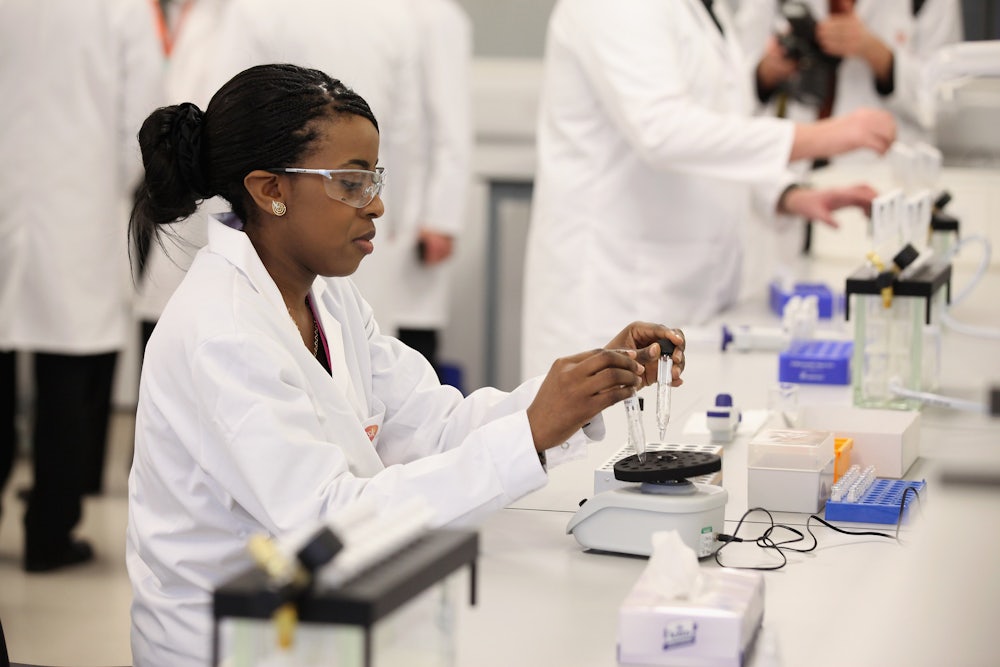My husband is a brilliant man with a deep love for home improvement shows. I could do that! he says. I just need a fancy saw, some tool, this other thing, wood and a plan. Sometimes these projects turn out great, but as often, we find we wasted money on equipment we can’t properly use, a plan we can’t follow and a project abandoned before it has taken shape.
Today’s scientists encounter similar challenges in their research programs. The cost and complexity of science and technology equipment have grown faster than science funding, and research has become so specialized that a gap has grown between the experiments scientists would like to do and the ones they can do.
In a market where the latest version of “Next Generation Sequencing” equipment approaches $1 million and is replaced as often as the iPhone, scientists struggle to afford the equipment and to maintain the scientific expertise for emerging technologies.
Yet to perform top-quality and cost-effective research, scientists need these technologies and the technical knowledge of experts to run them. When money is tight, where can scientists turn for the tools they need to complete their projects?
Sharing resources
An early solution to this problem was to create what the academic world calls “resource labs” that specialize in one or more specific type of science experiments (e.g., genomics, cell culture, proteomics). Researchers can then order and pay for that type of experiment from the resource lab instead of doing it on their own.
By focusing on one area of science, resource labs become the experts in that area and do the experiments better, faster and cheaper than most scientists could do in their own labs. Scientists no longer stumble through failed experiments trying to learn a new technique when a resource lab can do it correctly from the start.
The pooled funds from many research projects allow resource labs to buy better and faster equipment than any individual scientist could afford. This provides more researchers access to better technology at lower costs—which also saves taxpayers money, since many grants are government-backed.
I run a resource lab at Georgetown University; most of the people who use my lab—my customers—are Georgetown researchers. We have state-of-the-art expensive equipment to detect biomarkers in tissues and expertly trained scientists to operate it.
But sometimes we have unused capacity: When scientific funding slows, or when my equipment has downtime between projects, my lab either loses money or misses an opportunity to generate revenue to support itself or invest in new technology. At the same time, there are researchers out there who could use my equipment, if only they knew it was available.
Connecting people on a scientific Craigslist
This is a common paradox, with several efforts under way to address it. For example, MIT has created several “remote online laboratories” running experiments that can be controlled via the internet, to help enrich teaching in places that can’t afford advanced equipment. Harvard’s eagle-i system is a directory where researchers can list information, data and equipment they are willing to share with others—including cell lines, research mice, and equipment. Different services work for different institutions.
In 2011, Dr. Elizabeth Iorns, a breast cancer researcher, developed a mouse model to study how breast cancer spreads, but her institution didn’t have the equipment to finish one part of her study. My resource lab could complete the project, but despite significant searching, Dr. Iorns did not have an effective way to find labs like mine.
Actively connecting scientists with resource labs, and helping resource labs keep their equipment optimally busy, is a model Iorns and cofounder Dan Knox have developed into a business, called Science Exchange. (I am on its Lab Advisory Board, but have no financial interest in the company.) A little bit Craigslist and Travelocity for science rolled into one, Science Exchange provides scientists and expert resource labs a way to find each other to keep research progressing.
Unlike Starbucks, resource labs are not found on every corner and can be difficult for scientists to find. Now a simple search provides scientists a list of multiple resource labs that could do the experiments, including estimated costs and speed—and even previous users’ reviews of the choices.
I signed onto Science Exchange soon after it went live and Iorns immediately sent her project to my lab. We completed the project quickly, resulting in the first peer-reviewed publication made possible through Science Exchange.
Opening doors
These newfound collaborations improve scholarship. Starting with that first project together, Dr. Iorns and I have developed a collaboration that has resulted in multiple published papers. That boosts both our careers, and, more importantly, furthers scholarship and learning.
They also improve science education. Dr. Bernadette Connors is an associate professor of biology at Dominican College, an undergraduate-focused college serving lower-income students. The college seeks to teach advanced techniques but lacks funds to buy the most recent lab equipment.
When teaching a modern technique (RNA sequencing), Connors used Science Exchange to find a resource lab to generate data for her classes to use. Another student collected water samples from a polluted local watershed; Connors used Science Exchange to find a lab to do meta-genomic sequencing in search of clues to the contamination’s source.
Beyond academic research, eight of the ten top pharmaceutical companies use Science Exchange to outsource experiments. In the past year, Science Exchange has seen use rise 500 percent. That sort of growth attracts investors: the company recently raised $25 million to expand its operations, including to additional universities.
When researchers and teachers are less restricted by their own institutions’ resources, doors open to advanced experiments, new collaborations and top-quality science. Sharing our limited resources more efficiently and more widely improves science itself.
![]()
This article was originally published on The Conversation. Read the original article.
